 |

|
 |

Dr.
Sanjaykumar Patel, MD, FACC practices diagnostic and interventional
procedures at the Sadler Clinic in the Houston, Texas
area. He was one of
the first interventional cardiologists in the Houston area
to use the transradial approach and has
performed
more than 1,000 transradial catheterizations.
Dr. Patel earned his Bachelor of Medicine & Bachelor
of Surgery from Smt. NHL Municipal Medical College, Gujarat
University in India. He completed his Internal Medicine at
New York Medical College, NY, where he served as Chief Resident
in 2003-2004 and then
completed a fellowship in Cardiovascular Medicine and Interventional
Cardiology at St. Vincent’s Hospital and Medical Center
in New York. He is board
certified in Interventional Cardiology, Cardiovascular Diseases,
Nuclear Cardiology, Echocardiography and Internal
Medicine.
Dr. Patel now runs
monthly transradial training courses in an effort
to promote the use
of the wrist approach.
A complete listing of educational offerings for the transradial
approach, including Dr. Patel's upcoming
courses, can be found on the Transradial
Training Courses page in Angioplasty.Org's
Radial
Access Center.
|
|
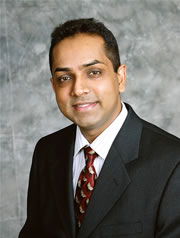
Sanjay Patel,
MD, FACC |
Q: How did you become interested in the transradial
technique and how did you learn it?
Dr. Sanjay Patel: I finished an interventional cardiology
program in June 2008 at St. Vincent’s Medical Center in New York and I witnessed the development
of the radial program there which was started back in 2003-2004. We became
the training site for the last couple of years and had an international faculty:
Dr. Shigeru Saito, Dr. Tejas Patel, Dr. Samir Pancholy and Dr. John Coppola,
who is my mentor and the program director at St. Vincent’s. All these great
transradialists came over and we had some great exposure in technique, the
essentials of transradial intervention and diagnostic angiography.
Plus, I'm from India and the city where I was born, Ahmedabad,
is where Dr. Tejas Patel's practice is. So every time I go there
I visit him, go to his cath lab and always learn more, always
there is something new. So that also helped me to get some exposure
outside of the United States. After finishing my fellowship I
moved here to Houston and accepted my first practice out of training.
| "Angioplasty.Org
is awesome; I always refer patients to it. It makes a difference
big time. They go and they look and see all the people
interviewed and these well-known cardiologists around the
world talking about it, and it takes that anxiety away. Ultimately
they sense your confidence in the way you tell them, and
they will go for it." |
|
Q: When you
came to Houston, were the people who hired you aware that
you did transradial?
Dr. Sanjay Patel: When I came here no
one was doing any transradial, zero. I was supposed to be
working at three hospitals: Memorial Hermann and St. Luke’s
Community Medical Center, both in the Woodlands, and Conroe
Regional Medical Center in Conroe, Texas. They all had cath
labs, very active interventional programs, and were private
hospitals -- no teaching programs. I expressed my interest
in transradial to the administration, cath lab supervisors
and management staff. They were happy to hear that and accommodated
all my needs for specialized catheters or introducer sheaths.
The
first 10 cases I did were all transradial and really established
the program in all three hospitals. The multi-specialty
practice I joined had six cardiologists and I was the seventh.
None of the six were doing transradial. They sort of had
an idea of it, that people had been doing it more and more,
but all of them were surprised to know this approach. Even
the 35 primary care and 50 internal medicine physicians
whom I met during the interview, they were all surprised.
For
some of them, it was the first time they'd even heard about
it. |
Q: What about the patients?
Dr. Sanjay Patel: As I started interacting with the patients and I discussed
with them the approach, wrist vs. femoral, at first they would
have no idea. You would see their mouths drop and they'd be surprised
and amazed, "Is this even possible?" They would look
at me suspiciously. The first few patients were like, "Doctor,
is this experimental?" And I had to refer them to your website,
Angioplasty.Org, to show them the literature.
Your website is awesome; I always refer patients
to it. It makes a difference big time.
They go
and they
look
and
see
all the people interviewed and these well-known cardiologists
around the world talking about it, and it takes that anxiety
away. Ultimately they sense your confidence in the way you tell
them, and they will go for it.
Q: Has using transradial
has been an advantage for you in your practice area, to differentiate
you from other hospitals and practices. Do you find that patients
are coming to you specifically because you do transradial?
Dr.
Sanjay Patel: Obviously it was new for everyone, including
the cath lab staff, the support nurses, the patients and the
family. After we did a few cases, we had a patient story put
out in a local newspaper. So that was a great head start. Everyone
became more aware. The referring physicians got involved. I
made some local presentations at the physician-to-physician
level.
I differentiated myself in the community because my doing
transradial was a huge advantage for me in attracting the patient
referrals -- because
all my patients, they loved it! |
|
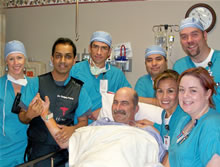
Dr. Patel,
Cath Lab Staff and 1st Radial Patient at Memorial
Hermann Hospital |
Since coronary artery disease is a chronic
disease, often the patient already has had a procedure done through
the femoral. Now
they come to me, for whatever reason, either their insurance changes
or they’ve relocated or they're changing their physician,
and now I do them through the wrist and they were my best advocate,
my best marketing tool. They went out and said, “Hey, great!
This is the same thing I had through the groin, but then I had
to lie down for hours.” Surprisingly, all they remembered
was how long they had to lie down after the femoral procedure.
Some of them had a bleeding complication requiring a blood transfusion,
increasing length of stay. But none of them would talk about the
heart attack or the angina. All they would mention were the complications.
When we went through the wrist, some of them went to work the
same day. Very quick recovery, no lying down, they could immediately
come out of the cath room and sit up, eat. Slowly I started getting
referrals from cardiologists in the community. It's a very competitive
market here.
I actually got several obese patients,
weighing 350-450 lb., who had been turned down by cardiologists
for catheterization because
the groin, the femoral artery, is simply not accessible in those
patients. And a couple of them needed bariatric surgery. But in
a 350 lb. patient a stress test is always going to be abnormal
because of artifacts, or it will be inconclusive and then they
would not get clearance for bariatric surgery or Lap-Band® or
whatever procedure they needed to have. It's ironic. But I was
able to do those patients through transradial and I could say, “You
have no problems. You're cleared for whatever surgery you need
to have done.”
Q: Do you do all of your cases transradially?
Dr. Sanjay Patel: My first preference is transradial. So far 94% of my
work is transradial. I check with an Allen’s test and very
rarely, if the right side is abnormal, I go for the left wrist.
Q: Have you had many complications from radial?
Dr. Sanjay Patel: So far I recall there were a couple of cases of local
hematoma, which resolved just with observation. So far no hand
ischemia, zero complications requiring blood transfusions or
increasing length of stay. There were a handful of patients with
some residual discomfort and pain for a week or so which resolved
eventually. That tends to go away in a week.
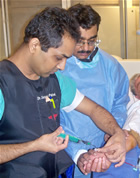 |
|
Q: You have started a training
program yourself and already have held several sessions this
year.
Dr. Sanjay Patel: After I started doing these cases there
was a lot of interest and a couple of cardiologists would come
stand next to me and say maybe you can show me all the tips
and tricks. And then the local representative of Terumo, which
makes
all the Glide Sheaths and catheters, they had their staff or
representatives from different areas including Denver, Dallas,
come here to spend the day with me.
I always wanted to spread
this technology and I said maybe we can come up with a training
program where the physician would come, spend a day with
me and, if possible, get hands-on training, and take it to
their
communities
and practices. |
Q: What do you think is the best way to learn this? Obviously,
if you're able to go to India and stand next to Tejas Patel, that's
wonderful, but it's not practical for everyone
Dr. Sanjay Patel: The best thing would be obviously, the fellowship training
program, incorporate radial in all the interventional cardiology
fellowship programs. Plus, for practicing cardiologists, I would
say there should be a sort of mini-fellowship, where the training
programs that are doing high radial volumes will have a week training
program on transradial and that would be very good for already
established interventional cardiologists.
Q: What about live demonstration courses?
Dr. Sanjay Patel: Those work -- obviously you can watch and pick up some
tricks and tips. But you want to have some hands-on experience,
including from the needle stick to passing the wire, to handling
the catheters -- because it is a completely different animal,
going from the wrist, as opposed to the groin.
What I see is the frustration
for someone who wants to learn this; they go out on their own
and they're trying to do the procedure radially and, if they
don't know how to troubleshoot, they will really get frustrated,
the procedure will get longer, the hospital is not going to
like it, the cath lab staff is not going to like it, the patient
is not going to like it. So there is only so much you can learn
by watching it.
I think you should really get involved, spend
time with someone who has been doing it. Just spending a
day is probably not enough. It could be a good start, but
you need
to really dedicate yourself and be persistent. You have to
be persistent. |
|
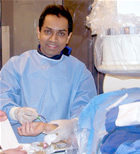 |
Q: When you came to Memorial Hermann and the other hospitals,
how did you work with the nursing staff, the technologists, to
teach them, because the set up is different, is it not?
Dr. Sanjay Patel: The first and foremost thing I did was have a meeting
with them. Then I had a little didactic session -- I showed them
with simple explanation how to even prep the patient, because they
never even prepped a transradial patient. I had a hand board ordered.
I showed them some slides. I made a formal presentation with everything.
And then, in the first few cases, I was there as the patient was
getting prepared from the beginning, like putting the patient on
the table and standing there and doing everything myself, showing
them this is what my expectations are, this is how you want to
do it.
So I had to go over some of the technical
aspects, which are very different than from the groin. It took
probably the first 10-15
cases before the whole cath lab staff was comfortable. And after
that, they just loved it. Because post-procedure I pull out the
sheath myself, I put the TR Band to achieve hemostasis, there is
no need to use any closure devices, complications are low, patients
are going home much faster and quicker post-PCI, regardless of
what anti-coagulation they are on, the sheath is coming out. It
facilitated the whole process so much that they just started loving
it. “This is great” -- that’s all I hear from
them now.
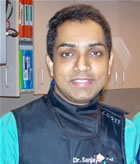
Sanjay
Patel, MD, FACC |
|
Q: What about the
hospital administration and the economics of doing transradial
as an
outpatient procedure? There’s a lot of incentive to cut costs.
Dr.
Sanjay Patel: I think the radial approach for both catheterization
and PCI should be the gold standard in the coming years. The
reasons being, number one, a tremendous amount of
cost saving if you look at the complications and the cost to
deal
with
those complications, including blood transfusion, imaging studies,
length of stay -- far more than managing coronary artery disease
with a procedure. Number two, there's greater and greater
emphasis on outpatient PCIs. I believe Medicare is now only paying
the
hospitals for outpatient PCI, regardless if you keep them in
the hospital or not. So, hospitals are already losing money keeping
patients overnight. In a couple of cardiology meetings, it came
up to do outpatient PCI and I was the first one and the only
one to say “yes” – to have my patients same day discharge. And
the reason is because of transradial. |
I have such a sense of confidence when I finish
my procedure through the wrist, I never have to worry about bleeding
complications and never have to worry about their ambulation or
any groin complications. We actually are going to start a pilot
project where we will be sending the patient out the same day after
transradial angioplasty. The hospital administration is very supportive
because of all this cost saving. And the patients love it. No one
wants to spend a day in the hospital unless they have to.
Q: This whole field of the transradial approach is growing.
Dr. Sanjay Patel: And recent studies about mortality, morbidity and PCI
outcomes now, we all know by all the studies looking at meta-analyses
and everything, that PCI outcome is directly related to the bleeding
complications. If you lower bleeding complications, you are hitting
the target to improve PCI safety, mortality and morbidity.
Q: Are there times when it's probably
best not to do radial, even if the Allen’s test is all
right? Are there certain procedures better done femorally?
Dr. Sanjay Patel: If you have distal peripheral arterial disease which
is below the iliac, up to iliac, I have done these cases through
the wrist. But anything below the iliac involving below the knee,
we do not have longer catheters or balloons, so there is a technical
limitation.
Carotid intervention is probably challenging, even though I see
some case reports from around the world where they are doing carotid
through the wrist, but I still see a major challenge in terms of
the technical equipment. The equipment is just not ready for that.
The other thing is anything requiring greater than a 7F procedure,
which is very rare actually. 90-95% of cases are being done with
a 6F intervention. So a minority of the patients who need some
complex PCI or large burr rotational atherectomy, bifurcation stenting,
those 7F or more would be a limitation because of the size of the
radial artery. But other than that, if you feel the pulse and if
your Allen is normal, then I think you should just go for radial.
Q: What about equipment?
Dr. Sanjay Patel: Most of the catheters and everything are designed for
the groin, but I think you are going to see more and more product
lines specifically for radial: Terumo has them, Medtronic has
started. My procedural time doing radial diagnostic cath is actually
shorter than femoral. The reason being that I use the Jacky Optitorque™ catheter
which I use instead of three different catheters: I go in, I
enter in the left ventricle and do my left ventriculogram, then
I get into left coronary, then right coronary -- just with one
catheter with no exchange, one does it all. The fluoro time,
as well as the procedural time, is shorter for a diagnostic coronary
angiogram with radial than with femoral.
It's also less expensive. The first time
somebody is watching and I go in and out and it's done, they're
like, “What?” Because
they normally see people exchanging catheters three times, over
the wire. And the safety is higher using one catheter because every
time you exchange the catheter, there is always the potential for
embolization. You maybe have a clot which you can dislodge, every
time you introduce the system in and out. So it makes an excellent
point to complete the procedure with one catheter.
Q: In the U.S. radial is used in less
than 5% of cases, as opposed to other countries like India, the
Netherlands and France. Why
is that and how do you think it could change?
Dr. Sanjay Patel: I think what we need is community awareness. Because
once we have community awareness, once the patients and the people
who need this procedure come to know about it, they will ask for
it. Once they start asking for it, there is going to be a growing
desire for getting trained. Certainly we can get help from the
societies. People are focusing already: they are talking at TCT,
they're talking at SCAI, and they’re talking at American
Heart Association, American College of Physicians annual meetings.
So, once we have those: societal support, community awareness and
more and more training sites, we will see the growth.
This interview was conducted
by Burt Cohen of Angioplasty.Org.
|






